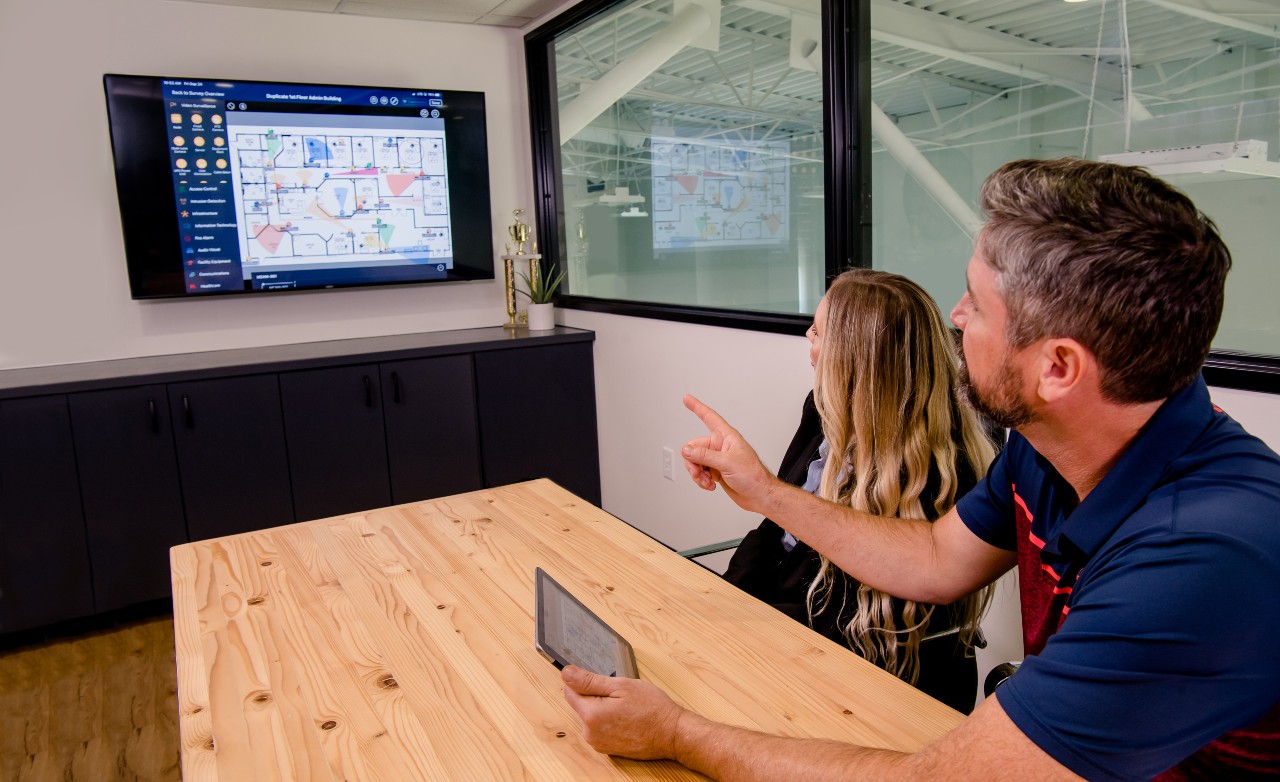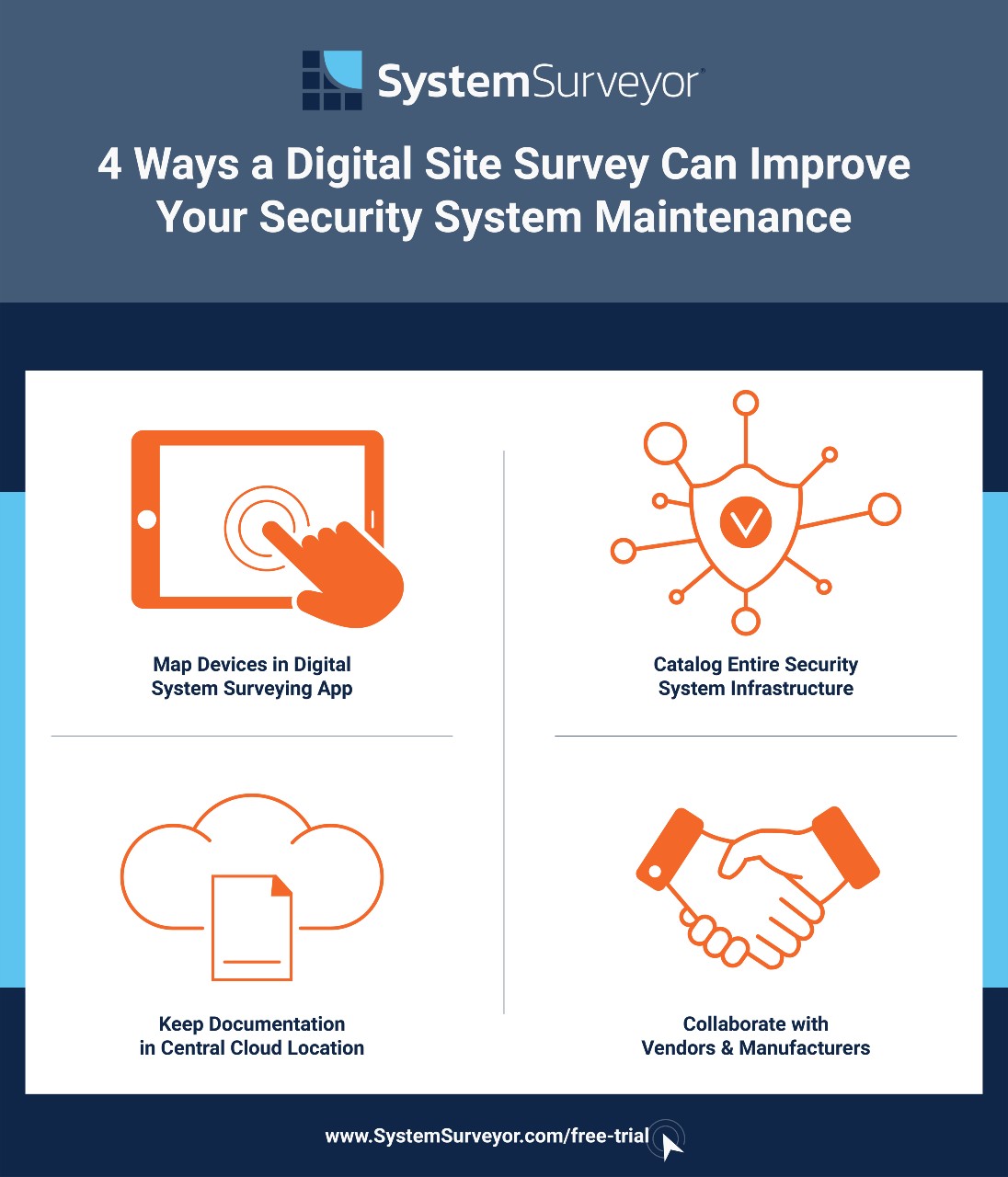Why a Digital Site Survey and Living As-Built Is the Solution
Organizations rely on security systems to protect people and property. These security and safety systems vary in complexity and components, and they can include a wide range of parts and pieces:
- Video surveillance and CCTV cameras
- Physical security measures like access control systems and intrusion motion detectors
- Smoke detectors and fire alarm systems
- Other sensors and systems like carbon monoxide sensors
Beyond those and other pieces of equipment, a security system also includes the physical and electronic infrastructure to power and connect those devices, including cable runs, mounting points, power connections, control panels, and so forth.
Whatever your security system looks like, every security system — from the simplest to the most complex — faces a similar ongoing challenge: routine maintenance.
Is keeping on top of preventive maintenance or even break-fix maintenance of your security system a regular pain point for you? If so, you’re not alone. Let’s examine the problem together and then walk through a new technology-powered solution to this frequent challenge.

Why Security System Maintenance Should Be a Top Priority
A security system is only as effective as it is operational and sustainable. Many organizations spend significant time and effort on security system design and installation. But without ongoing preventative maintenance checks, what was that initial investment for?
If a security camera goes down or a door is left ajar or an access-control module malfunctions and an incident occurs, the security system is compromised— in other words, it has failed in its mission to protect people and property.
Regularly checking all security equipment (such as by annual inspection) is the only way to keep your organization’s safety systems in excellent condition, thus ensuring your security alarm systems can reliably do their job: keeping people and property safe.
The Numerous Challenges of Regular Maintenance Checks for Security Systems

We hardly need to make the point that security system maintenance is important. The problem isn’t knowing that this should be a priority; the problems come when you try to do regular maintenance.
Problems such as these discourage organizations from performing adequate maintenance service or frustrate their efforts to do them well.
1. No Current As-Built for Security Systems
One of the biggest problems we’ve seen for physical security professionals and their partners and service providers is the absolute lack of an up-to-date “as-built” or in other words map of the system-of-record of their security system. It’s difficult to adequately maintain a system if you don’t know, comprehensively, what’s in the system and where those elements are physically located.
Yet many organizations have no such map or as-built. Or, if they have one, it’s a PDF schematic from when the system was first installed, paired with a spreadsheet perhaps or maybe a drawing with some icons or markup.
That’s better than nothing, but not by much: the moment that PDF was created, it “froze” in time. The system as it exists right now likely wouldn’t match a PDF made two months ago — let alone years ago.
So, with no system of record (or an ineffective one that’s out of date), organizations have no effective way to catalog what to check, where those things are, and when they were last checked.
There’s a great need throughout the physical security industry for a dynamic, “living as-built” — a digital form of documentation that can be updated in the moment, every time a change is made.
2. Systems are Constantly Changing
The rate at which security systems morph and change is another complicating factor for organizations that don’t have a living as-built. It’s not uncommon to add new devices or to change or move existing ones as you perform corrective maintenance or make minor changes to a building’s layout. For example:
- A door that didn’t need a motion sensor before may need one now.
- Turning a closet into an office might demand moving an alarm panel or monitoring panel.
- A camera may need to be moved or repositioned due to a traffic workflow change.
These changes further obscure a PDF and spreadsheet workflow.
Legacy technology or inoperable equipment that must be replaced are another source of change that can be challenging to track.
3. Loss of Institutional Knowledge
Retirement and resignations form another complicating factor: some organizations manage to get by because of that one individual who knows “everything” about the system. (Often this individual is not nearly as on top of the system as might be assumed, but that’s a separate discussion.)
What happens when your system guru retires, or takes a job at another organization? Your institutional knowledge of what’s where (or what all has changed since that seven-year-old PDF) walks out the door.
For these reasons and more, keeping up with what a system contains is an ongoing challenge for any security professional. Regularly and thoroughly checking the components of the system depends on solving that challenge.
Thankfully, there is now technology available to assist in this process to maintain and sustain a mission-critical physical security system more proactively. With a digital life cycle management tool, security professionals can track system components in real time, update the as-built when changes occur (including with accessories), and note on the as-built when a device goes offline or needs to be replaced.
System Maintenance (Proactive) vs. System Monitoring (Reactive)
At this point we want to distinguish between system monitoring and system maintenance.
Monitoring is simple, reactive technology: there are many system monitoring applications available, and many organizations have access to these as a service through a maintenance plan or maintenance contract.
A monitoring service is valuable and is certainly better than nothing at all. These services can show that something is down or offline, which is information you certainly want to have.
But they fall far short or must be in addition to a system maintenance tool.
Maintenance is proactive rather than reactive, working to avoid the situations where something goes offline in the first place. A proper maintenance tool involves features like these:
- Maintenance schedules: Yes, your cameras and card readers need some regular maintenance to keep operating smoothly and to extend their useful life.
- Inspection and inspection tracking: Did you (and when did you last) inspect a device, and what did you find?
- Mean time-to-failure and upgrade timelines: Every device has an end of life; proactively planning upgrades offers numerous advantages to playing whack-a-mole with an aging system.
- Details about when software upgrades are due: Security systems and devices have come a long way, and the software and firmware that powers them is more complex than ever before. Outdated devices and systems become vulnerable to exploitation.

System maintenance goes far deeper than just system monitoring. So do the tools that empower organizations to track and perform this maintenance.
Remember that a system is only as good as the combination of all its functioning parts. When a camera goes offline, it isn’t always the camera itself to blame. It could be the NVR or the cabling, for example. Holistic system maintenance takes care of all these elements, where monitoring is concerned only with a yes or no answer to whether the camera is working.
The Need for a Living, Accurate Map of System Assets
The biggest need facing most physical security professionals is the need for a living, accurate map of system assets, one that can be easily updated over time as their security assets evolve. Rather than a dead as-built that reflects a single point in time, this kind of living digital as-built grows and changes with your system, providing a map of system assets that’s as accurate as you make it.
This kind of living as-built is essential to a true security system life cycle management tool, which is why you’ll find the ideal implementation within System Surveyor.
4 Ways a Digital Site Survey Can Improve Your Security System Maintenance

As we wrap up this month’s article, we’d like to leave you with some actionable quick tips for shoring up your maintenance plan and for better tracking and mapping your existing system.
1. Maps all devices in a digital, collaborative system surveying app
You can’t maintain what you don’t know about, which is why maintaining a digital, updatable map of all devices in your security system is priority number one. Doing so in a digital, cloud-based platform that allows seamless collaboration? Even better.
2. Catalogs infrastructure, not just endpoint devices
Remember that your endpoint devices cannot function without behind-the-scenes infrastructure like cabling (network and power), access points, control panels, NVRs, cloud integrations, power and so on. These infrastructure elements present the same problem as endpoint devices: you can’t fix or maintain what you don’t know about. So, catalog these elements along with your endpoint security devices. (The best software tools make it simple and straightforward to do so.)
3. Keeps your documentation in a central Cloud location
Paper printouts get lost, and PDFs stored on a person’s computer can disappear forever. On the other side of the coin, emailing sensitive documents around as attachments is hardly a secure way to collaborate. Keep your documentation — whether it’s dead or living — in one central, controlled cloud location, so it stays both secure and available.
4. Collaborates with vendors and manufacturers
The security technology landscape is shifting rapidly. When devices fail or reach end of life, replacing them with an identical product may not be the strategic move. Work with vendors and manufacturers to identify which new technologies and products could enhance your current capabilities.
Netting it Out: Be More Dynamic and Proactive to Keep People and Assets Safer
At the core of all of this is the need for better digital tools for designing, cataloging, and tracking changes to your physical security system. If you’re ready to explore a true lifecycle management tool, one packed with collaborative and cloud-based features, System Surveyor is worth a look. Reach out today for a demo of System Surveyor and try it for free.
